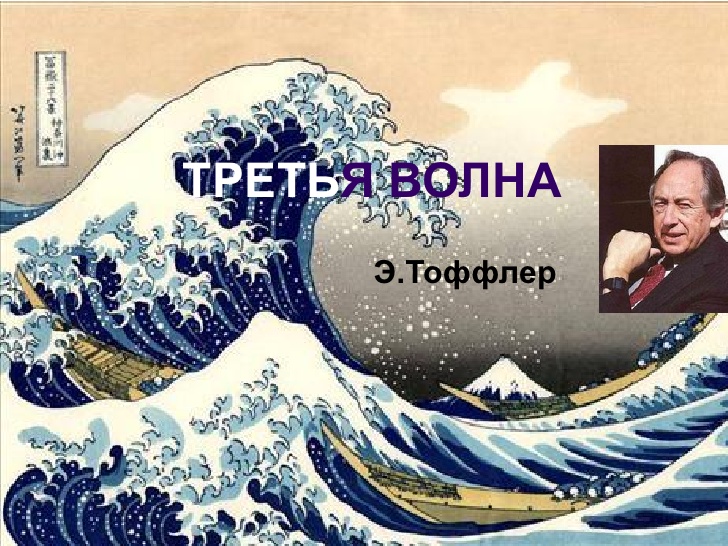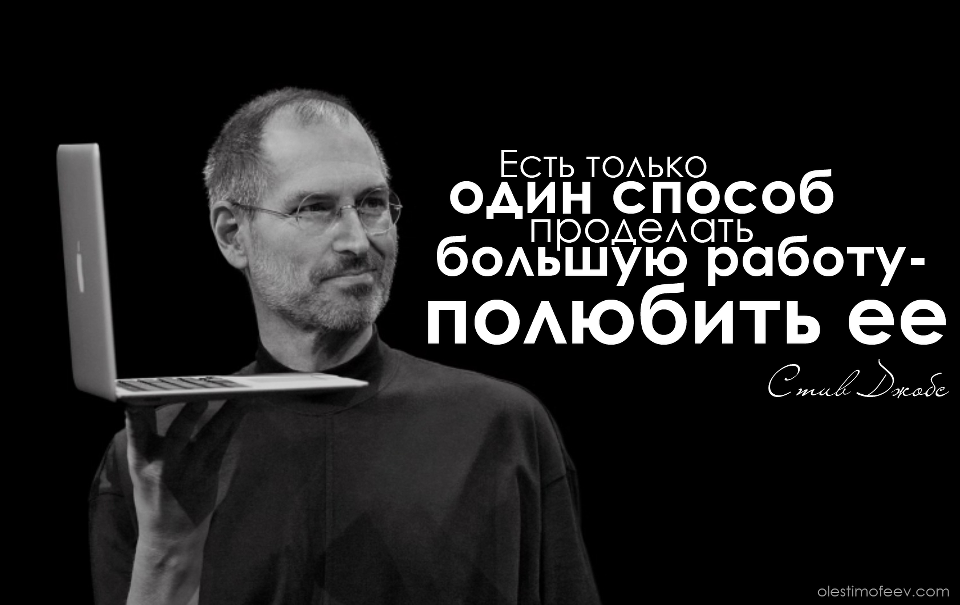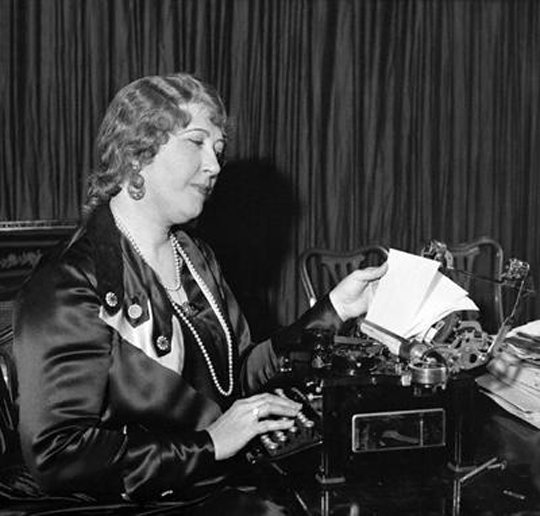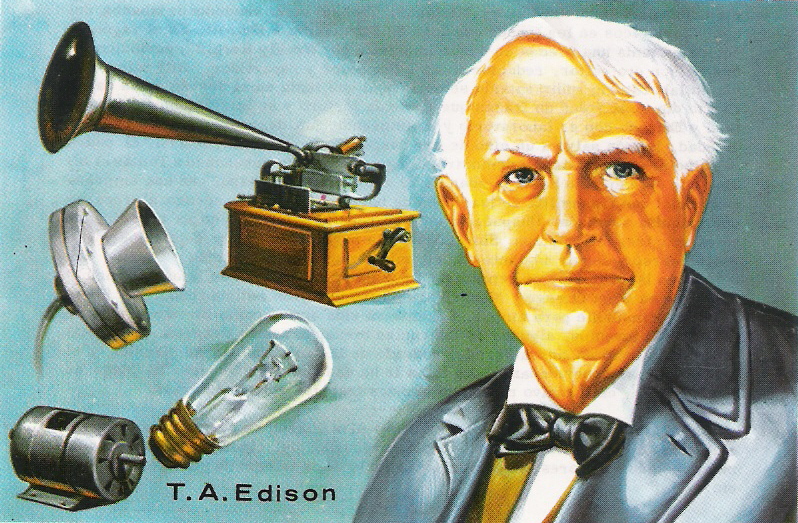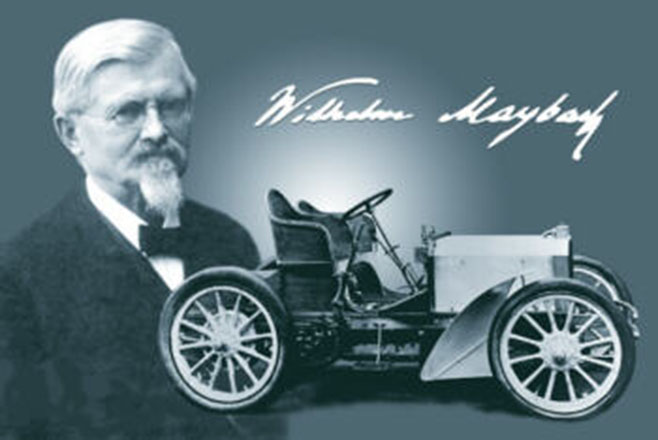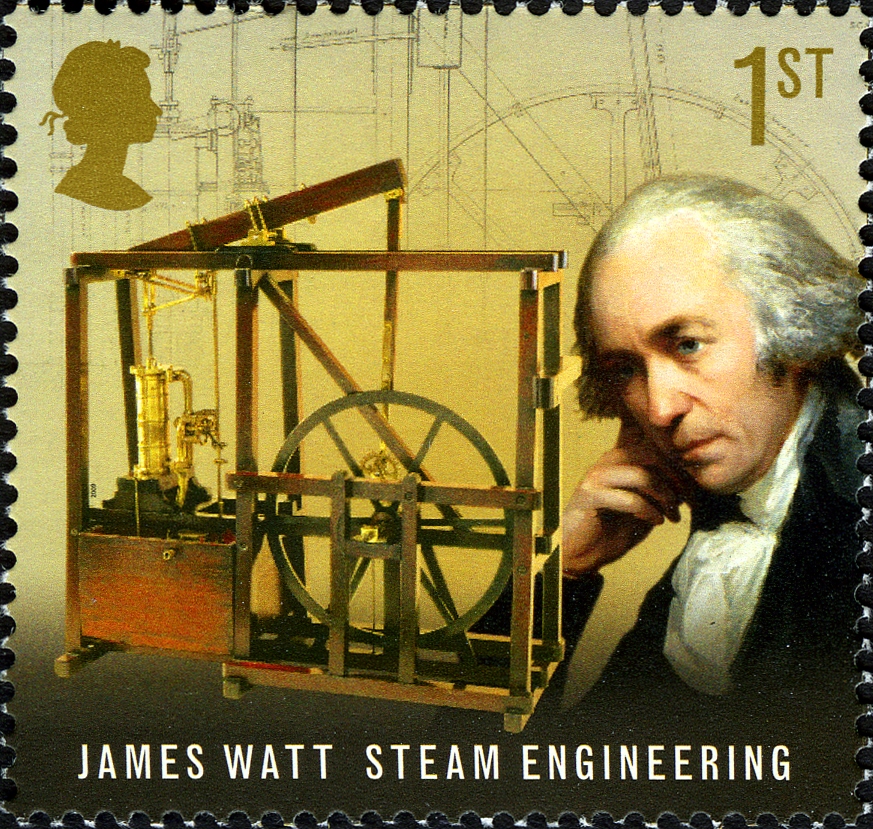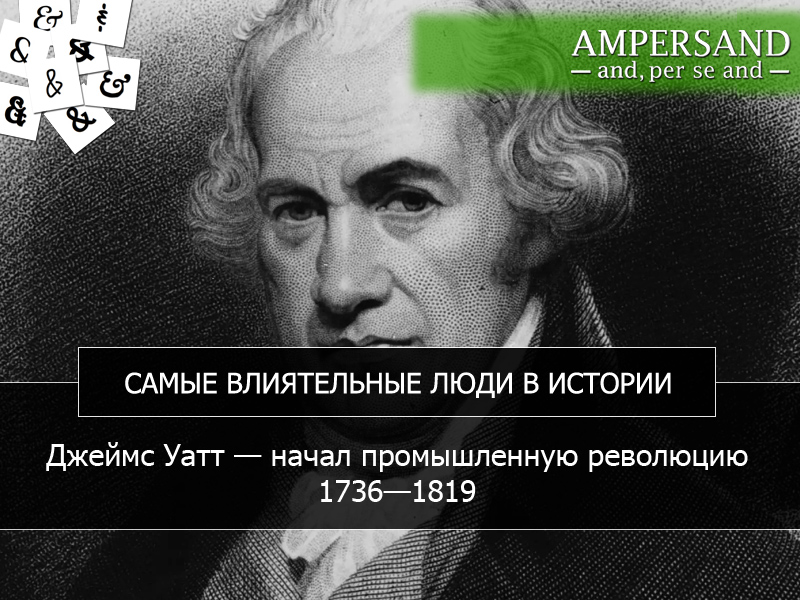“The Third Wave” by futurist Alvin Toffler – excerpts from the book
“The Third Wave is a book for those who think that human history is still very far from its end, that it has only just begun.”

“Many of today’s changes are interconnected and not random. For example, the destruction of the small family, the global energy crisis, the spread of “cults” and cable television, the rise of flexible work and fringe benefits agreements, the emergence of separatist movements from Quebec to Corsica – all these may seem like isolated phenomena. However, another point of view is correct. In fact, all these phenomena are components of another much larger phenomenon – the death of industrialism and the growth of a new civilization.”
“The Third Wave is a work of large-scale synthesis. The book describes the old civilization in which many of us grew up, and gives an accurate and comprehensive picture of the new, emerging civilization.
This new civilization is so profoundly revolutionary that it challenges all our old assumptions. The old ways of thinking, the old formulas, dogmas and ideologies, although they flourished or were very useful in the past, no longer correspond to the facts. The world, which is emerging with tremendous speed from the collision of new values and technologies, new geopolitical relations, new lifestyles and methods of communication, requires completely new ideas and analogies, classifications and concepts. We cannot squeeze the embryonic world of tomorrow into the categories accepted yesterday. Orthodox social attitudes or sentiments also do not suit this new world.”
“If the book’s central argument is correct, there is good reason for long-term optimism, even if the transition ahead of us now is likely to be turbulent and full of crises.”
“Intelligent readers understand that no one – neither a historian, nor a futurologist, nor a planner, nor an astrologer, nor a preacher – “knows” and cannot “know” the future. When I say that something “will happen,” I assume that the reader will make appropriate adjustments to account for the uncertainty. Doing it differently will result in overloading the book with a mass of difficult and not so necessary information. Moreover, social forecasts are never unbiased or scientific, even if they use a wealth of computerized data. “The ‘third wave’ is a biased forecast and does not purport to be scientifically based.”
“The idea of a wave is not only a way to organize huge masses of rather contradictory information. It also helps us see what lies beneath the turbulent surface of change. When we use the wave metaphor, much of what seemed quite confusing becomes clearer. Often the already familiar appears before us in a new, dazzlingly bright light.
Once I began to think in terms of waves of change that collide and overlap to create conflict and tension, I began to think differently about change itself. In every field – from education and health to technology, from personal life to politics – it has become possible to distinguish innovations, whether cosmetic or simply continuing our industrial past, to truly revolutionary innovations.”
“A new civilization is dawning in our lives, and those who are unable to see it are trying to suppress it. This new civilization brings with it new family relationships; other ways to work, love and live; new economy; new political conflicts, and on top of all this – an altered consciousness. Pieces of the new civilization already exist. Millions of people are already adjusting their lives in accordance with the rhythms of tomorrow. Other people, afraid of the future, run into a hopeless, useless past; they are trying to restore the dying world in which they were born.
The beginning of this new civilization is the single most explosive fact of the time in which we live.
This is the central event, the key to understanding the day following the present. It is a phenomenon as profound as the First Wave of change brought about by the introduction of agriculture 10,000 years ago, or the stunning Second Wave of change associated with the Industrial Revolution. We are the children of further transformation – the Third Wave.”

“Humanity is facing drastic changes. It faces a profound social upheaval and a creative reorganization of all time. Without yet clearly distinguishing this stunning new civilization, we are participating in its construction from the very beginning. The main meaning of writing “The Third Wave” is connected with this. Up to the present time, humanity has experienced two huge waves of change, each of which essentially destroyed earlier cultures or civilizations and replaced them with a way of life that was incomprehensible to the people who lived before. The first wave of change – the agricultural revolution – took millennia, to eradicate itself. The second wave – the rise of industrial civilization – took only 300 years. Today, history is accelerating even further, and it is likely that the Third Wave will sweep through history and be completed within a few decades. Those who happened to live on our planet during this explosive period will fully feel the impact of the Third Wave.”
“This new civilization, insofar as it opposes the old, will dismantle the bureaucracy, reduce the role of the nation state, and promote the growth of semi-autonomous economies of the Post-imperialist world. It requires new, simpler, more effective and democratic governments. It is a civilization with its own ideas about the world, with its own ways of using time, space, logic and causality.”
“Starting with the very simple idea that agricultural growth was the first turning point in human social development and the industrial revolution was the second great breakthrough, this analysis views them as waves of change moving at a certain speed rather than as discrete one-time events.” .
“Today the First Wave has virtually died out. Only a very few tribal communities, such as those in South America or Papua New Guinea, have yet to be involved in agricultural activities. However, the strength of this great First Wave has largely been spent.
Meanwhile, the Second Wave, which revolutionized the course of several centuries of life in Europe, North America and other parts of the globe, continues to spread as many countries that were previously predominantly agricultural struggle to build steel mills, automobile factories, textile factories and food processing plants, as well as railways. The moment of industrialization is still palpable. The second wave has not yet completely lost its strength.
Although this process is still ongoing, another, even more important process has begun. As the influx of industrialism reached its peak in the aftermath of World War II, a little-understood Third Wave began to sweep across the earth, transforming everything it touched.
Therefore, many countries are simultaneously experiencing two or even three very different waves of change, all moving at different speeds and carrying different forces.”
“And in order to understand the collisions of waves of change in our days, we must be able to clearly distinguish between parallel structures in all industrial countries, to see the hidden basis that is inherent in Second Wave civilization, because it is this industrial basis that is now being shaken.”
“A necessary condition for any civilization, old or new, is energy. First Wave societies used the energy of “living batteries” – the muscular power of humans or animals – as well as the energy of the sun, wind and water. All Second Wave societies began to extract the energy they needed from coal, gas and oil – fossil fuels, which are non-renewable.”
“The second wave took technology to a whole new level. It gave birth to gigantic electromechanical machines, driving various parts, belts, hoses, bearings and bolts, moving with a roar and crackling sound. And these new machines did more than simply increase the strength of living muscles. Industrial civilization developed sensory technology, creating machines that could hear, see, and feel with much greater precision than humans were capable of. She gave birth to the technology of the womb, inventing machines designed to create in an endless progression of new machines, that is, machines for the production of machines. Even more important, it brought together many interconnected machines under one roof, creating factories and plants and, ultimately, production lines within one enterprise.”
“However, this Second Wave technosphere… demanded radically new forms of social organization.”
“…since the mid-19th century, as the Second Wave crossed one country after another on its path, there has been a consistent expansion of education: children start going to school at an ever younger age, the school year becomes longer and longer (in the United States it duration increased by 35% between 1878 and 1956, and the number of years of compulsory schooling increased steadily.
Together, the family and the factory school formed part of a single integrated system for preparing young people for their roles in industrial society. And in this respect, Second Wave societies, whether capitalist or socialist, northern or southern, are all the same.
In all Second Wave societies, another organization arose to provide social supervision to the first two. This invention is known as a “corporation”. Before this happened, the typical business enterprise was owned either by an individual, a family, or a community. Corporations were exceptionally rare.”
“Moreover, the corporation has come to be viewed as an “eternal being,” in the sense that it can outlive its original investors. In turn, this meant that she was able to implement fairly long-term plans and take on large projects that were not possible before.”
“Many other organizations have sprung up around these three core institutions. Government ministries, sports clubs, churches, chambers of commerce, labor unions, professional organizations, political parties, libraries, ethnic groups, recreational groups, and thousands of others emerged in the wake of the Second Wave, creating an exceptionally complex organizational ecology that required each group to be served, coordinated, and balancing the interests of all groups.”
“And even in art we find some principles inherent in factory production. Musicians, artists, composers and writers do not work for any patron, as was customary during the long reign of agricultural civilization, but are increasingly dependent on the mercy of the market place. Increasingly, they are becoming “commodities” intended for anonymous consumers. And as this shift occurs in every Second Wave country, the very structure of artistic activity changes.”
“During the First Wave civilization, all these communication channels were intended only for the rich and powerful; ordinary people did not have access to them.
The second wave, involving country after country in its sphere, completely destroyed this communication monopoly. This happened not because the rich and powerful suddenly became altruistic, but because Second Wave technology and mass production required “massive” movements of information that the old communication channels simply could not handle.”

“The wave of mail messages that accompanies the industrial revolution is by no means the entire amount of information that came in the wake of the Second Wave. A much larger number of messages were disseminated through what can be defined as “micropost systems” within large organizations.”
“Thus, in all industrial societies, both capitalist and socialist, a well-developed Infosphere has grown up – communication channels through which individual and mass messages can be distributed as efficiently as goods and raw materials. This Infosphere is intertwined with the techno- and socio-spheres it serves, helping to integrate economic production with individual behavior.”
“The two halves of human life that were divided by the Second Wave are production and consumption. For example, we are used to thinking of ourselves as producers or consumers. But it was not always so. Before the Industrial Revolution, the bulk of all food, goods and services created by people were consumed by the producers themselves, their families, or a very thin layer of elite who managed to scrape together the surplus for their own use.”
“In short, industrialism destroyed the unity of production and consumption and separated the producer from the consumer. The single economy of the First Wave was transformed into a stratified economy of the Second Wave.”
“At the same time, the splitting of these two aspects – consumer and producer – within a person led to a split personality. One and the same person who, as a producer, was raised by family, school and superiors at work to limit her desires, to be disciplined, controlled, limited, obedient, that is, to be a player of her team, at the same time, being a consumer, she was taught to seek immediate satisfaction of one’s desires, to be more cheerful than prudent, to avoid discipline, to strive for personal pleasure – that is, in short, to be a completely different person. In Western countries, all the firepower of advertising is trained on the consumer, encouraging him to borrow money, buy when he wants, “fly now, pay later” and, acting in this way, fulfill his patriotic duty, keeping the economic mechanism moving.”
“… it is obvious that as soon as the invisible wedge separated the producer from the consumer, after that a series of profound changes took place: in order to connect them, a market had to appear; new political and social conflicts arose; new sexual roles were defined. However, such a split also meant something much more. It also meant that all Second Wave societies had to operate in a similar way, to satisfy the same basic requirements. There was no difference whether profit was the goal of production or not, whether the “means of production” were public or private, whether the market was “free” or “planned,” whether the rhetoric was capitalist or socialist.”
“The most familiar of these Second Wave principles is standardization. Everyone knows that industrial societies produce millions of exactly the same products.”
“Despite other disagreements, the leading thinkers of the Second Wave shared a consensus about the effectiveness of standardization. Thus, the second wave erases differences through the relentless application of the principle of standardization.”
“The second great principle common to all Second Wave societies is specialization. Because the more the Second Wave smoothed out differences in language, leisure and lifestyle, the more it needed differences in the world of work. Intensifying them, the Second Wave replaced the peasant, the temporary and unprofessional “jack of all trades”, with a narrow specialist and worker performing only a single task, over and over again, according to the Taylor method.
“The widening gap between production and consumption brought about a change in the attitude of the people of the Second Wave up to the time. Depending on the market system, whether it is a planned market or a free market, time equates to money. Expensive machines cannot be allowed to sit idle, so they operate according to their own rhythms. This gives rise to the third principle of industrial civilization – synchronization.
It wasn’t just work life that was being synchronized. In all Second Wave societies, regardless of profit or political considerations, social life also became dependent on time and adapted to the demands of machines. Certain hours were set aside for leisure. Vacations of standard duration, holidays or breaks were included in work schedules.”
“The growth of the market gave rise to another law of Second Wave civilization – the principle of concentration.
First Wave societies relied on widely dispersed sources of energy. Second Wave societies are almost entirely dependent on highly concentrated natural fuel reserves.”
“The gap between production and consumption also gave rise in all Second Wave societies to the disease “Macrophilia” – a type of Texan passion of enormous proportions and constant growth.”
“The principle of Macrophilia is so deeply rooted in the industrial mentality that nothing seems more reasonable and rational here. Maximization goes hand in hand with standardization, specialization and other basic principles of industrialism.”
“Finally, all industrial nations have brought centralization to the highest degree of perfection. Although the Church and the First Wave rulers were well aware of the centralization of power, they dealt with less complex societies and were only pathetic amateurs compared to the men and women of centralized industrial society at their lowest level.”
“In addition, the gradual centralization of a previously decentralized economy was also aided by a crucial innovation whose very name reveals its purpose: the central bank.”
“Thus, we see a system of six leading principles, a kind of “program” that, to one degree or another, operates in all countries of the Second Wave. These half-dozen principles – standardization, specialization, synchronization, concentration, maximization and centralization – can be applied to both the capitalist and socialist wings of industrial society, since they inevitably grew out of the same basic gap between producer and consumer, and thanks to the ever-increasing the role of the market.
In turn, these principles, reinforcing each other, inexorably led to the growth of bureaucracy. They created the largest, toughest and most powerful bureaucratic organizations that have ever existed on earth, leaving man to wander in… a world of ghostly mega-organizations. And if today we feel that they are suppressing and enslaving us, we can trace the source of our problems to the hidden code with which Second Wave civilization is programmed.
The six principles that make up this code leave a clear imprint on Second Wave civilization. Today, as we will soon see, each of these fundamental principles is under attack by Third Wave forces.
Indeed, there are Second Wave elites still applying these rules in business, banking, labor relations, management, education, the media. The growth of a new civilization challenges all legitimate interests of the old one.
In the shifts and upheavals that will soon take place, the elites of all industrial societies, so accustomed to established rules, apparently face the fate of the feudal lords of the past. Some of them will remain. Some will be defeated. Some will be reduced to a state of complete powerlessness or pathetic, poor nobility. Some – the most intelligent and adaptable – are transformed and transformed into leaders of the Third Wave civilization.”
“Today, when the Third Wave of changes begins to punch holes in the fortress of managerial power, the first signs of this appear in the system of power. Demands for participation in management, decision-making, worker, consumer and civil control, and democratization are heard in one country after another. In more advanced industries, less hierarchical and more specialized new ways of organizing production emerge. Pressure is increasing to decentralize power. Managers are increasingly dependent on information received from subordinates. The elites themselves are becoming less permanent and less durable. All this is just a harbinger, signs of impending fundamental changes in the political system.
The third wave, which has already begun to destroy industrial structures, opens up unprecedented opportunities for social and political renewal. In the coming years, our unfit, oppressed, outdated integrated structures will be replaced by amazing new social formations.”
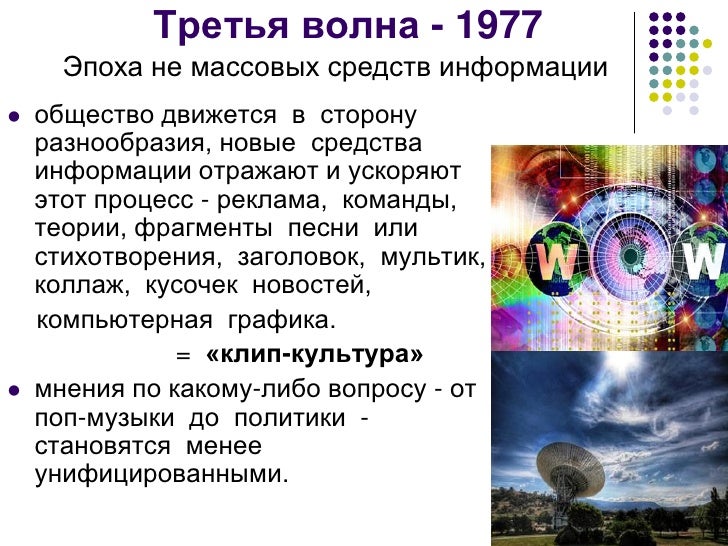
“By the middle of the 20th century, tens of thousands of seemingly sovereign and completely independent bodies of political power, scattered throughout the planet, found themselves in one bundle thanks to the coordination of the economy, unprecedented growth in transport, migration and the development of communications, and therefore they intensified their activities, encouraging each other to be active.
Thousands of political machines, assembled from the components of a representative set, gradually formed one invisible supermachines: a general legislative mechanism. We now only have to consider how the levers and control devices of this worldwide system operate and who controls it.”
“…civilization depended heavily on fuel resources, industrial production, the nuclear family, the corporation, mass education and the media, and at the core of all was the increasing divergence between production and consumption, and the leadership of all was left to managerial elites whose task was in the integration of the social system.”
“…the political unit of the Second Wave had to correspond to the development of the economic units of the Second Wave.
It is not surprising that as Second Wave societies began to build national economies, a decisive shift in public consciousness became apparent. Small-scale local production in First Wave societies produced a breed of very provincial people, most of whom identified themselves only with the place where they were born or with the village. Interests that went beyond the boundaries of a given area were only in a very small group (titled persons and clergy, individual merchants, and also actors, scientists and hired workers had such interests).
The second wave quickly increased the number of people willing to take risks in the big world in the hope of profit.”
“There is no civilization that has expanded its range of action without conflict. The Second Wave civilization quickly launched a massive offensive against the First Wave world, prevailed, and imposed its will on millions, and ultimately billions, of people.”
“To expand and integrate the world market, industrial states acted harshly. Because there were no borders to trade, each national market became part of larger regional or continental markets and eventually became incorporated into a single, unified monetary system created by the integration elites who developed Second Wave civilization. A single monetary network was woven around the world.”
“The Second Wave states waged an increasingly bloody battle among themselves for power over the emerging world economic system.”
“The Second Wave civilization divided and founded the world in the form of disparate nation-states. Needing the resources of the rest of the world, it drew First Wave societies and remaining primitive peoples into the monetary system, creating a globally integrated market space. But imperialism was more than an economic, political or social system. It has also become a way of life and a way of thinking. It gave birth to the Second Wave mentality.
Today this mentality is the main obstacle to the creation of a truly feasible Third Wave civilization.”
“With the advent of the Second Wave civilization, capitalist industrialists appeared, who pump out natural resources in huge quantities, release large amounts of poisons into the air, and, in the pursuit of profit, cut down the forests of entire regions, not caring at all about the side effects or long-term consequences. The idea that nature is something to be exploited provided a convenient rationalization for short-sighted and selfish businessmen.
But the capitalists were not at all alone. Whoever was in power, they or the Marxist industrializers (despite the belief that profit is the source of all evil), everyone acted in this way.”
“The third defining idea of industrial reality, closely related to nature and evolution, was the principle of progress, which asserted that history flows inexorably towards a better life for humanity. This idea was also developed quite a bit in pre-industrial times. However, it was only with the advent of the Second Wave that the idea of Progress with a capital P blossomed in full bloom.
Suddenly, as the Second Wave rolled across Europe, thousands of voices were heard praising progress.”
“The Second Wave civilization created a completely new image of reality, based on unique ideas about time and space, matter and causality. By collecting the fragments of the past, combining them together in a new way, using experiments and empirical research, she radically changed people’s ideas about the world around them and about themselves in this world.”
“Second Wave Civilization did not simply divide time into more precise and standardized parts. She placed these parts in a straight, endless line that stretched back into the past and forward into the future.
Indeed, the idea of linear time is so deeply ingrained in our thinking that most of us raised in Second Wave societies struggle to imagine any alternative. However, many pre-industrial societies and some First Wave societies even today perceive time in the form of a circle rather than a straight line. In the Mayans, Buddhists and Hindus, time is circular and eternally repeats itself, history repeats itself endlessly, and even life could repeat itself through reincarnation.”

“Thus, our idea of space and the experience of organizing space were associated with the process of its linearization, which occurred simultaneously with the linearization of time. In all industrial countries, capitalist or socialist, both in the East and in the West, the architectural organization of space, the drawing up of detailed maps, the use of uniform, clear units of measurement and, above all, the straight line became a cultural constant and formed the basis of the new industrial reality.”
“…industrial reality contributed to the development of the concept of personality, where a person was almost like an atom, representing an indivisible, unshakable, basic part of society.”
“… the Hindu-real image of the universe, the ideas it generates, have largely influenced our way of life in its personal, social and political manifestations. From such a point of view on the world, it inevitably arose that not only space and nature, but also society and people acted according to well-defined and predictable laws. The outstanding thinkers of the Second Wave were precisely those who most logically and convincingly proved the connection and interdependence of the phenomena of objective reality.”
“Industrial reality was not at all morally neutral, although it pretended to be so. It represented, as we have seen, the militant super-ideology of the Second Wave civilization, from which all the main ideological trends of the industrial era, both left and right, arose. Like any culture, the Second Wave civilization created a distorted mechanism for man’s perception of himself and the world around him. A complex of ideas, images, and ideas has been developed – and analogies arise from them – and turned out to be a powerful cultural system in the history of mankind.
And finally, industrial reality, the cultural face of industrialism, prompted society to develop in the right direction. It created complex organized entities, large cities, a centralized bureaucracy, and an all-encompassing market, whether capitalist or socialist. This was perfectly consistent with new energy systems, family structure, technology, economic relations, political and spiritual values, and together created the Second Wave civilization.
So it turns out that this entire civilization, along with all organizations and institutions, technology and culture, is being destroyed under the influence of changes brought about by the Third Wave, which is sweeping across the planet. We live in the final, crisis period of irrevocably retreating industrialism. The industrial era is fading into history, a new era is being born.”
“The Second Wave civilization not only changed technology, nature and culture. She changed her personality, contributing to the emergence of a new social type. Of course, both women and children constituted and were shaped by Second Wave civilization. But still, mostly men directly fell into the whirlpool of market relations, embodied new methods of work, they more clearly than women showed the characteristic features inherent in a given period, and educated women also possessed these new qualities, fully consistent with the concept of the industrial person. era.”
“Ultimately, the combination of all these factors (loss of basic subsidies, malfunctioning of the main life support systems of society, collapse of the role structure) causes a crisis in the initial and most fragile of structures – the human personality. The collapse of Second Wave civilization leads to an epidemic of identity crisis.”
“I am confident that today we stand on the threshold of a new era of synthesis. In all fields of knowledge – from the hard sciences to sociology, psychology and economics, especially economics – we are likely to see a return to large-scale thinking, to general theory, to putting the parts back together into a whole. Therefore, it becomes clear that our desire to consider quantitative details taken out of context while studying more and more precisely smaller and smaller problems leads to the fact that we learn more and more about less and less.
It follows that our approach will be to consider the streams of change that are shaking our lives, not simply because each of these streams is important in itself, but because these streams of change merge and form even larger, deeper, faster rivers of change, which in turn merge into something more: the Third Wave.”
“Today we again stand on the threshold of a historic leap in technology, and a new production system is now emerging that will require a radical reconstruction of the entire energy business, further if OPEC folds its tents and slowly leaves.
“Most of the energy reserves will be provided by renewable, rather than waste, sources. The energy base of the Third Wave will not depend on fuel sources concentrated in several places; it will also use a whole range of energy sources scattered in many places. Dependence on highly centralized technologies will decrease, and both centralized and decentralized energy production will be combined. And instead of dangerously relying too much on a handful of methods or energy sources, many different methods and energy sources will be offered. It is this diversity that will reduce waste as we can match the types and quality of energy produced to the growing diversity of needs.”
“A boom has begun in industries or sectors of the economy based on Third Wave technologies; Second Wave production began to wane. Today, many governments are consciously trying to accelerate these structural changes, trying to make the transition as painless as possible.”
“One thing is certain: we are no longer locked into the electromechanical framework of traditional Second Wave technology of three centuries ago, and we are only just beginning to understand the full significance of this historical fact.
Just as when the Second Wave combined coal, steel, electricity, rail transportation to produce cars and thousands of other life-changing things, we will not feel the true impact of new changes until we reach the stage of combining new technologies – computers, electronics , new materials from outer space and the depths of the ocean – with genetics and all this, in turn, with a new energy base. Combining these elements together will unleash a flood of innovation unlike anything seen before in human history. We are creating a dramatically new technosphere for the Third Wave of civilization.”
“Technological revolutionaries consider technologies that are “appropriate” to be those that humanize work, prevent pollution, and protect the environment. They prefer projects designed for the local rather than the state or global market. Around the world, tech revolutionaries are conducting thousands of experiments with small-scale technologies, from fish farming and food production to energy production, waste recycling, low-cost construction and simple transportation.”
“Now the Third Wave is radically changing all this. As changes in society accelerate, we ourselves change. We are constantly being overtaken by new information, and we are forced to constantly revise the card index of images. Old images relating to a past life must be replaced by new ones, otherwise our actions do not correspond to the new reality, we will become more incompetent. It’s impossible to cover everything.”
“The third wave began a completely new era – the era of non-mass media. Along with the new technosphere, a new Infosphere is emerging, and this will have far-reaching consequences in all areas of life, including our consciousness. Taken together, these changes revolutionize our understanding of the world and our ability to understand it.”
“Now we do not receive a ready-made mental model of reality; we are forced to constantly form and reshape it. This places a heavy burden on us, but it also leads to greater individuality, demassification of both personality and culture. Some of us crack under such pressure, retreating, feeling apathetic or angry. Others constantly grow, shape themselves and become competent, literate people capable of performing at the highest level.”
“By now creating a new infosphere for the Third Wave civilization, we are endowing the “sluggish” environment around us with intelligence. The key to such a decisive step forward was, of course, the computer.”
“Now we are ready to jump to a new level of social memory. Drastic demassification, the invention of new media, satellite mapping of the earth, hospital monitoring of bedridden patients using electronic sensors, computerization of corporate files – all this means that we are recording in detail the activities of our civilization. Unless we cremate our planet, and with it our social memory, we will soon come very close to the civilization of “photographic” memory. The Third Wave civilization will have at its disposal much more and much better organized information about itself than could have been imagined even a quarter of a century ago.”
“…the essence of Third Wave manufacturing is a short run of partially or fully customized products.”
“The next step is, of course, full custom production – making a one-of-a-kind piece. And of course, in what direction should we move in custom-made products for the individual consumer?
“So the model is clear. Enormous changes in the technosphere and infosphere have converged, changing the way products are manufactured. We are rapidly moving beyond traditional mass production to a complex mixture of mass and non-mass products. The ultimate goal of this effort is now clear: the production of only custom-made products, made in a seamless, continuous process under the ever-increasing direct control of the customer.
In short, we have revolutionized the deep structure of production, causing a series of changes in every layer of society. However, these changes, which force the student to plan a career, production – investment, and society – development strategy, cannot be understood separately. They need to be seen in direct connection with another revolution – the revolution in the office.”
“The double revolution in white collar and manufacturing will lead to a completely new way of producing for society – a giant step forward for all of humanity. It will influence not only the level of employment or the structure of industry, but also the distribution of political and economic power, the number of jobs, the international division of labor, the role of women in the economy, the nature of work and the gap between producer and consumer; it will change even such an apparently simple fact as the “place” of work.”
“Third Wave white collar work, like Third Wave manufacturing, does not require a 100% presence of the workforce in the workplace.”
“The ‘Electronic Cottage’ could serve as an idea for the Third Wave forces of tomorrow.”
“These enormous historical shifts alone may justify the claim that we are on the verge of a new civilization. But we are simultaneously restructuring our social lives, from family and friendships to schools and corporations. We are on the threshold of creating, along with the technosphere and infosphere, the sociosphere of the Third Wave.”
“The advent of the third wave, of course, does not mean the end of the nuclear family, just as the advent of the second wave did not lead to the complete disintegration of the extended family. It’s just that the family can no longer serve as an ideal model for society.”
“It simply means that from now on the nuclear family will be only one of many socially accepted and approved types. When the Third Wave arrives, the family system will no longer be massive, just like the production and information systems of society.”
“In other words, the expansion of work from home on a large scale may not only affect family structure, but also change family relationships. To create a shared experience and get spouses to talk to each other again, to change “cold” relationships to “hot” ones, and to redefine love and bring with it the idea of “plus Love.”
“E-Cottage opens up an alternative route for youth to re-enter society into economically productive pursuits, and we may soon see political campaigns not against, but for, child labor, along with the fight for the necessary measures to protect them from gross economic exploitation.” .
“In addition, it is easy to imagine a completely different type of family working in the home: the ‘electronic extended family’.”
“This new family system will be the main institution in the new sociosphere, which will be formed next to the technosphere and the infosphere. This is part of social creativity with the help of which our generation adapts to and creates a new civilization.”
“It is clear that, like the family of nuclear states, like schools, mass consciousness and other major institutions of our time, corporations are falling apart, being shaken and transformed by the Third Wave of change. And even many senior managers do not know what awaits them in the future.”
“Today, when the Third Wave arrived, the corporate leader realized that all his old attitudes were problematic. The mass society for which corporations were conceived ceases to be mass. Not just information, products and family life, but the stock exchanges, as well as the labor market, are beginning to break down into smaller, more diverse pieces.”
“Corporations can therefore no longer hold on to just new specialized economic functions, but, under pressure from critics, legislation and their own leaders, become multi-purpose institutions.”
“The transformation of corporations is part of larger transformations in the social sphere as a whole, which are occurring in parallel with dramatic changes in the technical and information sphere. Taken together, they caused enormous historical shifts. But we’re not just remodeling these giant structures. We also change the daily lives of ordinary people. When we change the deep structures of civilization, we must simultaneously rewrite all the codes of our lives.”
“…if we look at the ways in which time is used in our society, we will find a gentle but powerful shift away from the rhythms of the Second Wave towards a new time structure for our lives. In fact, there has been a demassification of time, which strictly parallels the demassification of other features of social life caused by the spread of the Third Wave.”
“…as the Third Wave spreads, replacing the old industrial mode of production, it completely changes the relations of civilization later. The old mechanical synchronization that destroyed so much of the spontaneity and joy of life and virtually symbolized the Second Wave is coming. Young people who reject the nine-to-five routine, are indifferent to classical punctuality, and may no longer even realize why they behave this way. But time has changed in the ‘real world’, and in accordance with this, we have changed the basic laws that previously governed us.”
“The impact of the Third Wave of changes is aimed at increasing diversity, at moving away from the standardization of life. The truth is that ideas, political opinions, sexual inclinations, educational methods, eating habits, religious views, ethnic positions, musical tastes, fashions and family forms are its automatically produced products. The historical point of return has been overcome, and standardization, like other basic principles of the Second Wave of civilization, is being replaced by new ones.”
“Only decoupling and increasingly decentralized control can work in a new economy that is progressively decentralized and at the same time seen as global and equal.
All these anti-center trends in politics, in the organization of corporations and governments, and in the economy itself are creating a completely new society and making yesterday’s rules obsolete.”
“In short, if you run through the codebook of Second Wave civilization from standardization to synchronization and on to centralization, maximization, specialization and concentration, you will see how, point by point, the old ground rules that determined our daily lives and methods of making social decisions are in the process of revolutionary transformations and upheavals caused by the Third Wave.”
“… the boundary between consumer and producer is increasingly blurred, and “the producer for himself” is becoming increasingly important. In addition, we do not clearly notice the gigantic changes that are transforming even the role of the market itself in our lives and in the world system.”
“…we are moving towards an economy of the future in which many people will never be employed full time or in which the concept of “full time” will take on a different meaning, as it did so recently when the work week or year became increasingly shorter ”
“The emergence of the ‘manufacturer for oneself’ is changing the entire economic landscape.”
“The third wave will create the first “trans-market” civilization in history.
By “transmarket” I mean a civilization… dependent on the market, and no longer consumed by the need to build, expand, develop and integrate that structure. A civilization capable of putting new tasks on the agenda, since the market has already been built.”
“When the Third Wave began, our home planet seemed smaller and much more vulnerable. We considered our place in the Universe less grandiose. And it is the remote possibility that we are not alone in the Universe that gives us time to think.
Our understanding of nature is no longer what it used to be.”
“Third Wave thinkers are now faced with an obvious fact: we are close to becoming the “designers” of evolution. Never before has evolution been looked at from this point of view.”
“The third wave changed our perception of the world, dispersing rather than concentrating the human community. … all technologically highly developed countries are already experiencing … these trends.”
“Causality in the Third Wave gives a picture of the world as a unity of forms of a system of interacting forces. The world is filled with amazing phenomena – changes that increase as well as decrease, many other phenomena; in any case, it is not a system of billiard balls that endlessly rush along predictable trajectories, crashing into each other on a cosmic gaming table. This world, more unfamiliar and alien to us than the mechanistic world, was offered by the Second Wave.”
“Today, as our understanding of nature has changed, nation-states are transforming themselves, taking the next step towards Third Wave civilization.”
“…we are creating a new multi-level world game, the participants of which are not only nations, but also corporations, trade unions, political, ethnic and cultural groups, transnational associations and supranational organizations. As the new world system takes shape, the nation-state, already threatened by pressure from below, loses more and more power.”
“In the coming decades we should expect the emergence of new global organizations capable of representing both national and post-national interests.”
“As the nation disintegrates and restructures, as transnational corporations and other new factors appear on the world stage, as instability and the threat of war grow, we will have to invent new political forms or “containers” to establish a semblance of order in this world – a world in which the state “The nation, for many reasons, is becoming a dangerous anachronism.”
“The rapid rise of the Third Wave not only marks the end of Second Wave empires, it also dashes our hopes of ending global poverty the old ways.”
“Obviously, in a world where there is increasing differentiation, we should not turn to models of the industrial present and the pre-industrial past, but look for completely new ways and look to the future.”
“The development strategies of tomorrow will come not from Washington or Moscow, not from Paris or Geneva, but from Africa, Asia and Latin America. They will be tailored to local needs. They will not develop the economy to the detriment of ecology, religion, culture, family traditions and the psychological atmosphere of existence. They will not try to imitate other people’s models. The first wave, the second and finally the third…
But the advent of the Third Wave puts all our efforts in a different perspective, as this approach provides entirely new opportunities for both the poor and rich nations of the world.”
“…a growing number of thinkers, sociologists, scientists and researchers believe that such a transformation is beginning today, leading us to a radically new synthesis, which can be figuratively described as follows: Gandhi and the Companions.”
“The third wave carries the potential for revolutionary changes not only in technology or energy, but also in the consciousness and behavior of the individual.”
“Both rich and poor stand at the starting line at the beginning of the journey to a new and strikingly different future for humanity today.”
“And at the same time, we expect to survive. And therefore it is important to know where the path of these changes leads us. What kind of world will we live in if we manage to avoid the dangers that await us? In other words, what shape will the society of the future take?
“Third Wave people will undoubtedly produce new ideas about nature, progress, evolution, time, space, matter and causality. Their thinking will be less mechanistic and more shaped by concepts such as process, feedback, imbalance. They will know better than us that a pattern can have a direct consequence of the absence of a pattern.
New religious movements will appear, new scientific theories, a new understanding of human nature, new types of art will arise, which have much greater diversity than in the industrial era. The emerging multiculture will be torn apart by contradictions until new forms of group conflict resolution develop (the legal system that currently exists is backward and will be unsuitable for a highly differentiated society).”
“…the civilization of the Third Wave is a praktopia, a practical future. It is a civilization that encourages individual development that welcomes racial, regional, religious and cultural diversity. Civilization is largely organized around the home. Civilization, not frozen, but pulsating, continuously generates new things, and at the same time is able to provide stability to those who need it. Civilization does not devote all its strength and energy to the market. A civilization capable of channeling strong passions into art. Civilization is faced with choices unprecedented in history (to give just one example – the choice between genetics and evolution) and the need to develop new ethical and moral standards on the basis of which this choice can be made. And finally, it is a democratic and humane civilization that maintains balance with the biosphere and does not fall into dangerous economic dependence on the rest of the world. Achieving all this is a difficult task. But doable.”
“To create the desired emotional life and healthy psychosphere for the emergence of the civilization of the future, we must recognize the three basic requirements of any individual: the need for community, structure and content. By understanding how the collapse of Second Wave society undermines these needs, we could begin to create a healthier psychological environment for ourselves and our children in the future.”
“However, it is not enough to change society. For as we create Third Wave civilization by solving our daily problems, Third Wave civilization will in turn shape us. A new Psychosphere is emerging, which will fundamentally change our character.”
“… our task is to look not for the mythical “man,” but for those character traits that are most likely to be valued by the civilization of tomorrow.”
“The personality of the future must be answered by the politics of the future.”
“The first heretical principle of Third Wave government is the principle of minority rule. It is not the majority that is taken into account, but the minorities. And our political systems must increasingly reflect this fact.”
“Today, in every area of public life – in our families, our schools, our businesses and churches, in our energy systems and communications – we are faced with the need to create new forms of the Third Wave, and millions of people in many countries are already beginning to do so.”
“So the responsibility for change lies with us. We must start with ourselves, learn not to close our minds to the new, the surprising, the seemingly radical. This means fighting the idea killers who rush forward to destroy any new proposal on the grounds that it is impractical, while defending everything that now exists as practical, no matter how absurd, oppressive and inactive it may be. This means fighting for freedom of speech – the right of people to express their thoughts, even heretical ones. It also means starting the process of reconstruction now, before further disintegration of existing political systems sends the forces of tyranny marching through the streets and makes a peaceful transition to 21st century democracy impossible.
If we start now, we and our children can take part in an exciting restructuring not only of our outdated political structures, but of civilization itself.
As the generation of the first revolutionaries, we were given the destiny to create.”

